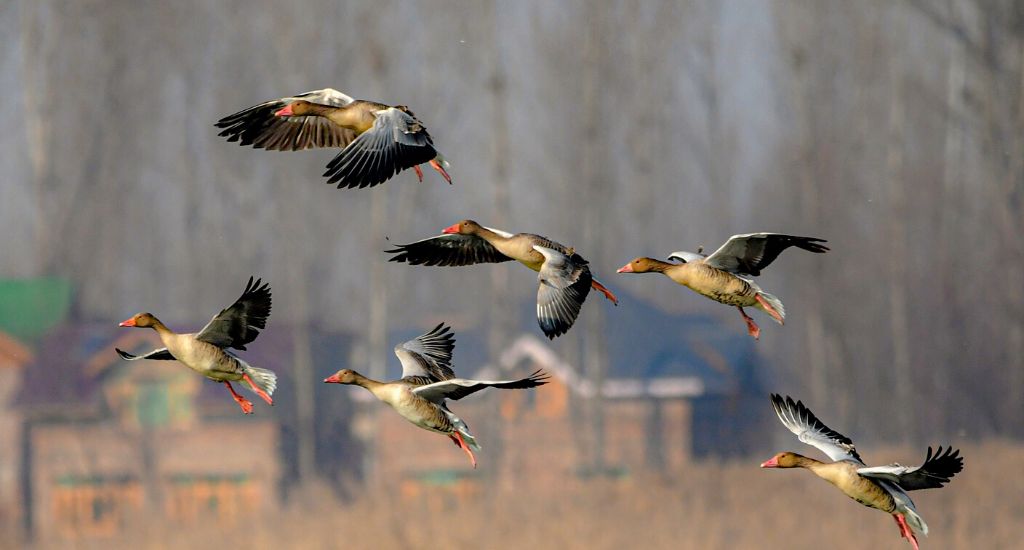
Death on the tail of migratory birds in Kashmir
In the cold winters of Kashmir’s wetlands, migratory birds that roost and breed there under the shadow of hunters and trappers, never mind climate change, threatening their annual visit.

In the cold winters of Kashmir’s wetlands, migratory birds that roost and breed there under the shadow of hunters and trappers, never mind climate change, threatening their annual visit.
Birdsongs in the backyard wake up 12-year-old Farwah in her home on the shores of Hokersar wetlands in central Kashmir. She gingerly opens her bedroom window, catches the January morning draught in her face, and looks out to confirm the source of the sounds coming through it.
Tufted Duck, Gadwall, Brahminy Duck, Gargantuan, Greylag Goose, Mallard, Common Merganser, Northern Pintail, Common Pochard, Ferruginous Pochard, Red Crested Pochard, Ruddy Shelduck, Northern Shoveler, Eurasian Teal, Eurasian Wagtail, Eurasian Wigeon, Coot… Oh boy, there’s so many!
Their repetitive cooing and cackling complete the sunrise chorus. Farwah can count her blessings for the incredible sight of thousands of migratory birds making her homeland their home for the winter.
“It’s so delightful to see them take off, glide in the air and land back on water,” she said, training her eyes on the birds roosting, nesting, flying in formation and composing a black silhouette line on the horizon.
For centuries these long-distance travellers have been coming in extraordinary numbers from regions snowed-out up north like Siberia, central Asia, Europe and China to the wetlands of the saucer-shaped valley of Kashmir flanked by high mountains.
From October to March, about five to seven lakh migratory birds are seen in Hokersar, Hygam, Prichal, Shallabugh, Wullar and Dal – lakes and protected wetlands where they feed and breed.
But unfortunately for Farwah, her wake-up call could become a childhood memory in the not-too-distant future because habitat loss, hunting and climate change are taking a heavy toll on the feathered visitors.
Also Read | Vanishing vultures find friends for their survival
Gunshots often ring out from paddy fields abutting the wetlands. Each shot means one kill.

Death means one less bird to provide valuable ecosystem services of pollinating crops and helping plants grow by dispersing seeds and preying on insects.
Bird-catchers fan out in the pre-dawn darkness, setting traps and nets in the field, throwing in handfuls of rice and corn as bait.
“Many birds forage in the fields and get killed by poachers,” said Ghulam Ahmad of Rambergarh, Srinagar.
The trappers employ devilish techniques. They scare the birds by making a noise, like banging pots and pans, or playing barks and howls of predators on portable speakers. The frightened birds take off in a rush and end up in nets and other traps.
A stagnant signal can mean the bird died a natural death. If it shuts off completely, there is every likelihood that the bird has been killed
The dead birds end up in markets as game meat sold on the sly.
“Don’t even think of a penny less than Rs 700,” said a man in his forties to a customer haggling over a dead migratory duck in a bazaar in Hajin of north Kashmir’s Bandipora. “We work hard and risk our lives,” he said.
Authorities are aware of the hunting. Range officer Sajad Ahmad admitted as much, but said most of the poaching happens outside the protected wetlands – trapped while they’re foraging and shot down when they’re flying.

Guards are always on the lookout for poachers.
“We’ve seized many guns and caught poachers and pressed charges against them,” the range officer said.
Also Read | Young twitcher becomes desert’s star birding guide
Some years ago, SKAUST Kashmir captured and released many birds after ringing them with a satellite tracking device as part of a research on the migratory birds’ range. The findings were astonishing, said researcher Dr Khursheed Ahmad, as many devices either stopped sending its signal or the signal went still.
“A stagnant signal can mean the bird died a natural death. If it shuts off completely, there is every likelihood that the bird has been killed,” Ahmad said. “Our team found devices damaged by poachers.”
It is illegal to pursue, hunt, take, capture, kill or sell live or dead migratory birds, as well as their feathers, eggs and nests. Migratory birds warrant so much attention because not only are hunters decimating bird populations across the country, but they face many other threats as well.

Habitat loss, invasive species, pollution and collisions with buildings and other structures are taking heavy tolls on many species.
Authorities and activists are stepping up efforts to persuade villagers to stop consuming game meat, but old habits die hard.
“My customers are spread across south and central Kashmir. They travel long distances to buy from me,” said a seller in Sumbal of Bandipora.
The hunters and the sellers are penny wise and pound foolish. A dead bird fetches Rs 700 or so, but a live one in the wild can be worth many times over as migratory birds contribute millions of rupees to the economy through recreational activities like birdwatching.
The wetlands of Kashmir are known as a birdwatcher’s paradise. Watching birds imparts a certain connection to nature that little else does and listening to their melodies alleviates stress.
But if the birds aren’t protected, the dazzling spectacle of migration could be all gone because birds range around the globe and if they feel threatened at one place, they won’t go there the next time.
The lead image at the top shows a group of Tufted Ducks taking a flight in the Hokersar wetland on the outskirts of Srinagar (Photo Credits: Reyan Sofi)
Nasir Yousufi is a journalist based at Srinagar.